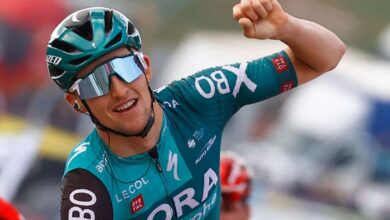How Mark Cavendish became a Tour de France legend – according to his fierce rivals and loyal teammates

Mark Cavendish once gave me the look.
It was an interview in a hotel lobby in Yorkshire; he was slightly late and apologised profusely, then answered questions about the Tour de France with enthusiasm and detail. For some reason, I thought 10 minutes of flowing conversation made me his trusted confidant, so I looked him in the eyes and asked: how much do you want to break Eddy Merckx’s Tour stage record? He shrugged it off. But what would it mean to you? He went quiet. Wouldn’t it crown your legacy?
The look was somewhere in the venn diagram of anger and disdain, and I half expected him to walk off. He stayed, but in that brief moment I felt the gentlest prod of his famous spikiness. Cavendish was once asked what he’d learned from a difficult day on the bike. “That journalists sometimes ask some stupid f***ing questions,” he replied.
Teammates, staff and rivals have all felt Cavendish’s sharp tongue. He would slam doors if a stage didn’t go to plan. Helmets were thrown.
“We stood on the bus after races and screamed at each other,” his former leadout man Mark Renshaw tells me.
Cavendish’s closest ally at the 2021 Tour, Michael Morkov, says of spending a month in each other’s pockets: “He’s definitely a character so it’s ups and downs. He has quite a temper.”
One of Cavendish’s greatest rivals, Marcel Kittel, tells a story from the Tour in 2012. “On the start line at different stages – it happened more than once – he was not happy with his bike computer and he was yelling and screaming at his mechanic, next to all the other riders. Everyone was just looking away [thinking] ‘you cannot do that Cav, it’s really crazy and it’s really disrespectful.’
“But everyone at the same time was like, ‘he can actually be a really nice guy’. It’s just… him.”
***
Renshaw was Cavendish’s loyal lieutenant through much of his career. On the surface there was little to unite a laid-back Australian with a hyped-up Manxman; one was stoic and calculated, the other often emotional and impulsive. But Cavendish needed Renshaw’s calm head on the road, and their temperaments complemented each other.
“I don’t think you could have two Mark Cavendishs in a team and that would work,” Renshaw says gravely, as if genuinely disturbed by the image he has created.
Cavendish disrupted the existing order straight away, winning four stages at his first Tour de France in 2008, and he was paired with Renshaw the following year. Their first leadout was a mess but “within six months we had it pretty much down pat”.
Their first Tour together would be Cavendish’s most fruitful, winning six stages in all, a rare feat (the record in a single Tour is eight). The highlight was undoubtedly the last day in Paris, winning on the Champs-Elysees where Renshaw finished behind him in a one-two. It was evidence that Renshaw could have been a winner in his own right, and “the world’s best leadout man” was soon recognised, not least by Cavendish who would eulogise about his friend.
Renshaw’s brief was to lead Cavendish through the melee and present him near the finish like a king on a cushion. He was sat nav, windshield and security operation all in one. “If I had to ride in the wind, if I had to move him up in a hard section… I’d do that bodyguarding around the peloton, because you’re not the most popular rider when you’re winning five stages in the Tour.”
Renshaw could have been jealous or competitive but he knew that they were different animals. “Stack us up against each other in training and I could get close. But where there’s a finish line and a big prize, he just goes that 1 or 2 per cent deeper than anybody else, he goes that little bit harder, hurts himself a little bit more. He’s got that extra drive and that cunning decision-making you need to be a winner.”
He was welcoming me on the top level of sprinters. He made that step towards me, not away
The team held a deep respect for Cavendish. “When he walked into the room, everyone lifts because they know he’s the best,” says Renshaw. And what stood out beyond the burgeoning collection of trophies and jerseys was a unique ability to deal with setbacks, to thrive in them.
“One of the moments that most shocked me was the year he had a massive crash in the Tour de Suisse. He took off skin from the top of the shoulders to his butt cheek – he took off his whole back. And he turned around two weeks later for the Tour and was straight back into winning. I just didn’t see that in many other riders.”
***
Cavendish was a nightmare to race against. His period of sprinting dominance was akin to Roger Federer or Tiger Woods, particularly at the Tour de France. There were 180 of the world’s most athletically outstanding humans on the startline competing for 21 stages, and for most riders just winning one was an unqualified success. Cavendish won 23 stages between 2008-2012, at 4.6 stages per Tour.
Cavendish and Renshaw embrace after winning stage 21 of the 2009 Tour in Paris
Cavendish celebrates beating Kittel, in blue, on stage on in 2016





